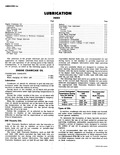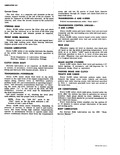Jeep Parts Wiki | Ford Parts Wiki
Home | Search | Browse
|
Corvair Chassis Shop Manual December 1964 |
|
Prev

 Next
Next
Maintaining Oil Level The oil gauge rod is marked Full and Add Oil These notations have broad arrows pointing to the level lines The oil level should be maintained between the two lines neither going above the Full line nor under the Add Oil line DO NOT OVERFILL Check the oil level frequently and add oil when necessary NOTE It is advisable when taking a long trip to recheck the oil level after the first 100 miles of the trip This is a precautionary measure due to the possibility of crankcase dilution which would give a false oil level reading The diluents which are usually the result of incomplete engine warm up traveling short distances are driven out of the crankcase with high speed driving temperatures Crankcase Dilution Probably the most serious phase of engine oil deterioration is that of crankcase dilution which is the thinning of the oil by fuel vapor leaking by pistons and rings and mixing with the oil and by condensation of water on the cylinder walls and crankcase Leakage of fuel or fuel vapors into the oil pan occurs mostly during the warming up period when the fuel is not thoroughly vaporized and burned Water vapor enters the crankcase through normal engine ventilation and through exhaust gas blow by When the engine is not completely warmed up these vapors condense combine with the condensed fuel and exhaust gases and form acid compounds in the crankcase As long as the gases and internal walls of the crankcase are hot enough to keep water vapor from condensing no harm will result However when the engine is run in low temperatures moisture will collect and unite with the gases formed by combustion resulting in an acid formation The acid thus formed is likely to cause serious etch or pitting which will manifest itself in excessively rapid wear on pistons pins crankshaft bearings and other moving parts of the engine oftentimes causing the owner to blame the car manufacturer or the lubricating oil when in reality the trouble may be traced back to the character of fuel used or a condition of the engine such as excessive blow by or improper carburetor adjustment Automatic Control Device to Minimize Crankcase Dilution The engine is equipped with automatic devices which aid greatly in minimizing the danger of crankcase dilution An automatic choke reduces the danger of raw or unvaporized fuel entering the combustion chamber and leaking into the oil reservoir An efficient crankcase ventilating system drives off fuel vapors and aids in the evaporation of the raw fuel and water which may find its way into the oil pan OIL AND FILTER CHANGE INTERVALS OIL To insure continuation of best performance low maintenance cost and long engine life it is necessary to change the crankcase oil whenever it becomes contaminated with harmful foreign materials Under normal driving conditions draining the crankcase and refilling with fresh oil every 6000 miles or every 60 days whichever occurs first is recommended See Note 3 It is always advisable to drain the crankcase only after the engine has become thoroughly warmed up or reached normal operating temperature The benefit of draining is to a large extent lost if the crankcase is drained when the engine is cold as some of the suspended foreign material will cling to the sides of the oil pan and will not drain out readily with the cold slower moving oil When checking or adding oil be careful to avoid spilling or dropping oil onto the engine shrouding OIL FILTER Change the filter element every 6000 miles or every six months whichever occurs first See Note 3 ENGINE OIL COOLER Every 12 000 miles remove cover and brush or blow out accumulated dirt See Note 3 CRANKCASE VENTILATION Valve Type At every oil change the valve should be tested for proper function and replaced when necessary Fixed Orifice Type Check at every oil change If dirty or plugged clear with suitable drill Twist drill by hand to remove any sludge or carbon formation See Note 3 Air Cleaner NOTE Under prolonged dusty driving conditions it is recommended that these operations be performed more often Paper Element Type First 6 000 miles inspect or test element if satisfactory re use element but recheck every 6 000 miles until replaced Element must not be washed oiled tapped or cleaned with an air hose Oil Bath Type Check every 6 000 miles Clean if necessary and refill with engine oil SAE 50 when temperature is above freezing and SAE 20 below freezing BATTERY Every 6 000 miles clean and oil battery terminals and oil felt washer Clean top of battery with diluted ammonia or soda solution and flush with clean water Check state of charge especially in freezing weather An undercharged battery may freeze and break DISTRIBUTOR CAM LUBRICATOR Every 12 000 miles rotate cam lubricator 180 degrees Replace lubricator at 24 000 mile intervals FUEL FILTER Corvair Replace filters located in each carburetor inlet only if flooding occurs CORVAR SHOP MANUAL

 Next
Next